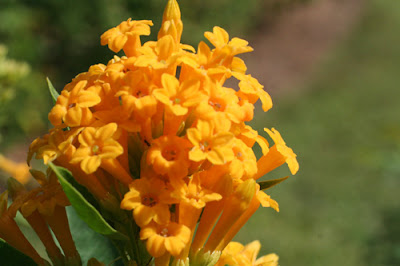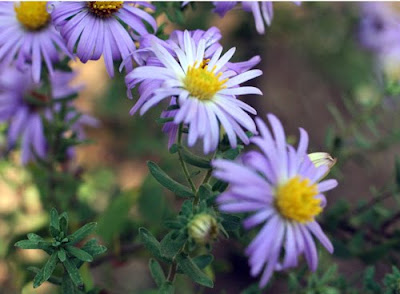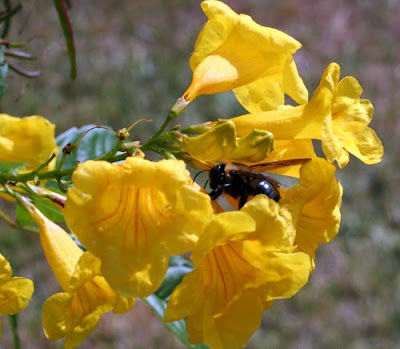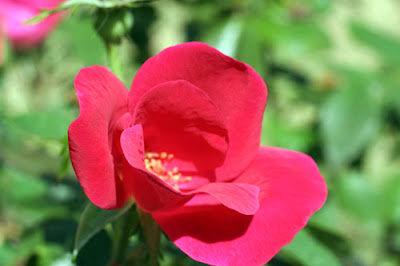This week we (and when I say "we", I mean Bob) took down the bottle tree. Long-time readers may remember that we had made the trunk of the tree from a cedar tree in our backyard that had been damaged by Hurricane Ike. I had a sentimental attachment to that tree because I had dug it at my parents' home in Mississippi, but in the end, it just wasn't working for me as a bottle tree. So, down it came. I've purchased a metal frame to hold my bottles but I don't have it installed yet. Next week, maybe.
In apite of all the wind which you would think would make life difficult for them, this has been the week of butterflies in my yard. A veritable butterfly convention has been going on all week.
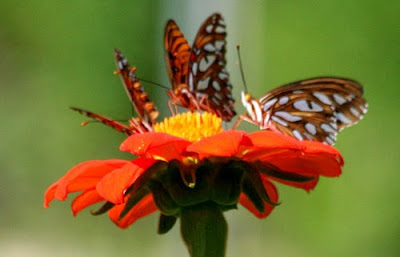
It might have something to do with the fact that the Mexican sunflowers (Tithonia) are in full and glorious bloom just now and that always draws the butterflies. It was not at all unusual to see multiple butterflies on one bloom, particularly Gulf Fritillaries who seem expecially fond of these sunflowers.

Occasionally, I would see more than one species of butterfly sharing a blossom, like this Gulf Fritillary and Brazilian Skipper.

But two or three of the same species were more common.
Sulphurs of many kinds were too numerous to count.

This (I think) is the Large Orange Sulphur.

And this is the very common Cloudless Sulphur. I've noticed that all of the sulphurs show a decided preference in their feeding for tubular flowers like this flame acanthus. I see them regularly on these flowers as well as Turk's cap, Hamelia patens, Cigar plant (Cuphea), and cannas, but not so much on daisy-like flowers like the Mexican sunflowers.

The Queens certainly favor the sunflowers.

I've had many, many Queens in my garden this fall, which is unusual. Normally, they have been rather uncommon here. Maybe their presence is Mother Nature's way of compensating me for my lack of Monarchs.

Many of the butterflies that I saw this week looked like they had been through a war, like this tattered Pipe-Vine Swallowtail feeding on blue plumbago.

None looked worse than this poor Red Admiral who had lost about half his wings and yet was still flying briskly and enjoying sunning himself on a post.

With his wings open, you can see even more clearly the damage that has been done to him. Never let it be thought that the life of a butterfly is all sunshine and nectar.

Even this tiny Gray Hairstreak has had a bite taken out of his hindwing.

Again, open wings show his injuries more starkly.
But not everybody looked beat up.

This Spicebush Swallowtail looked pristine and perfect in every way, as if he had just stepped out of his chrysalis.

With wings in ventral position, you can see the two parallel rows of orange dots on the wings that identify him as a Spicebush.

There was competition for a prime spot on the blossoms, and it wasn't just among the butterflies.

Bumblebees like these flowers, too.
The high point of my day of butterfly watching came near the end of the day.
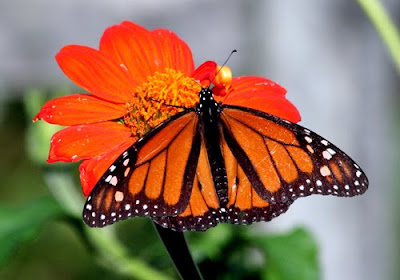
Yes, that really is a Monarch! In fact, it was the second Monarch I had seen this day. The other one had flown over my house and didn't stop, as far as I know. But this guy seemed inclined to stick around for awhile. I know he's a guy because of those two enlarged black dots on one of the black veins on his hindwing. Those are scent patches which male Monarchs and Queens have but the females do not have. So, no eggs from him, but maybe he had a girlfriend hiding in the bushes.
You might think that I took a picture of every single butterfly in the yard, but there were a few that I missed. There were also Long-tailed Skippers here. In fact, there were probably many kinds of skippers that I missed. And I know there was at least one Common Buckeye and one Giant Swallowtail. Like I said at the beginning, it was a veritable butterfly convention. A sight to warm the cockles of a habitat gardener's heart!

